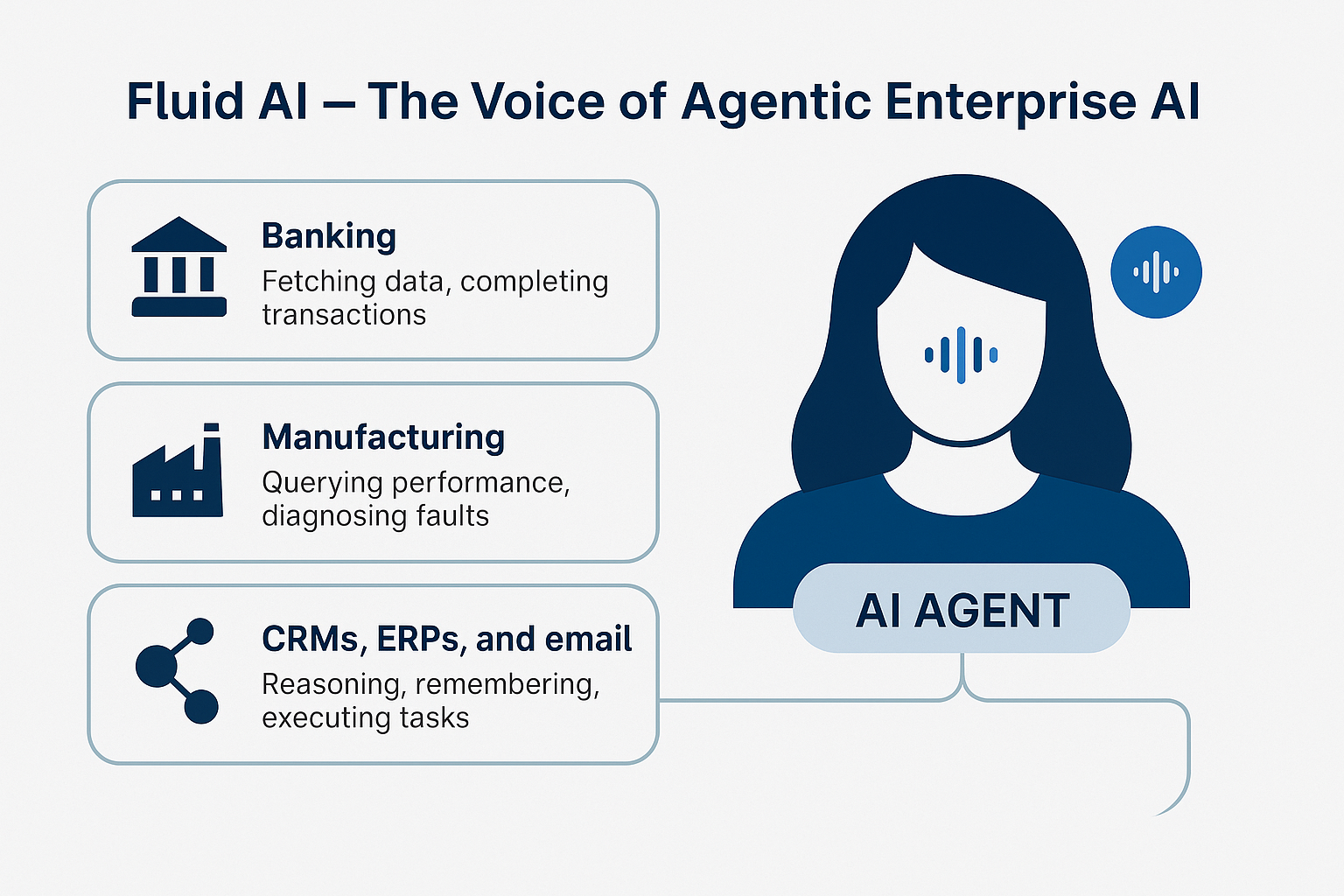Join our WhatsApp Community
AI-powered WhatsApp community for insights, support, and real-time collaboration.
Discover the top 5 Voice AI leaders—Fluid AI, Deepgram, SoundHound AI, Yellow AI, and CrewAI—powering the next era of intelligent, voice-driven enterprise automation.

| Why is AI important in the banking sector? | The shift from traditional in-person banking to online and mobile platforms has increased customer demand for instant, personalized service. |
| AI Virtual Assistants in Focus: | Banks are investing in AI-driven virtual assistants to create hyper-personalised, real-time solutions that improve customer experiences. |
| What is the top challenge of using AI in banking? | Inefficiencies like higher Average Handling Time (AHT), lack of real-time data, and limited personalization hinder existing customer service strategies. |
| Limits of Traditional Automation: | Automated systems need more nuanced queries, making them less effective for high-value customers with complex needs. |
| What are the benefits of AI chatbots in Banking? | AI virtual assistants enhance efficiency, reduce operational costs, and empower CSRs by handling repetitive tasks and offering personalized interactions. |
| Future Outlook of AI-enabled Virtual Assistants: | AI will transform the role of CSRs into more strategic, relationship-focused positions while continuing to elevate the customer experience in banking. |
For years, text-based chatbots carried the weight of automation. Now, voice AI is stepping in—bridging emotion, trust, and efficiency.
In banking, retail, travel, and telecom, enterprises are turning their phone lines into living ecosystems where customers can speak naturally, get answers instantly, and complete real actions—without waiting in queues or navigating menus.
The common thread? A convergence of speech recognition, natural language understanding, and reasoning. The best voice AI companies today don’t just listen—they comprehend, decide, and act.

Fluid AI sits at the intersection of reasoning, memory, and multimodal communication — creating AI agents that can understand, decide, and act through voice.
Where most voice AI tools are designed as interfaces, Fluid AI builds autonomous voice agents that are embedded directly into enterprise workflows. These agents don’t just talk — they reason, remember, and execute tasks across systems like CRMs, ERPs, and email platforms.
A banking customer calling in doesn’t just hear a natural voice — they’re speaking to an intelligent system capable of fetching data, completing transactions, and following up via email or chat. A manufacturing executive can speak directly to the factory floor’s digital twin — querying performance, diagnosing faults, or instructing maintenance agents — all through conversational voice commands.
Fluid AI’s edge lies in its Agentic AI architecture: a reasoning layer that connects voice to enterprise intelligence. Rather than a standalone assistant, it turns voice into an action channel — the start of an autonomous workflow that ends with outcomes, not tickets.
For leaders exploring enterprise-scale voice automation, Fluid AI represents the evolution from “talking bots” to thinking systems that speak.

.png)
Deepgram stands out for its voice infrastructure expertise. It’s not a chatbot maker — it’s the engine that powers many of them.
Enterprises use Deepgram’s APIs for speech recognition (STT), speech synthesis (TTS), and real-time voice analytics. The company’s focus on custom model training, low latency, and on-premise deployment makes it particularly relevant for industries like banking, telecom, and healthcare — where accuracy, privacy, and compliance matter as much as speed.
Its acoustic and language models are built for enterprise-scale throughput — transcribing thousands of hours of conversations with industry-specific vocabulary. Deepgram is often the invisible infrastructure behind the voice agents that enterprises build on top of it.
In an age where businesses are looking to own their conversational data while retaining AI power, Deepgram offers that balance: voice intelligence without exposure.

SoundHound AI has long championed the belief that voice can be the default human-technology interface. From automotive dashboards to restaurant kiosks, it’s leading the movement toward “voice everywhere.”
Unlike general-purpose LLM-based assistants, SoundHound’s platform focuses on real-time understanding in noisy, dynamic environments — a challenge that most enterprise systems struggle with. Its patented “Speech-to-Meaning” approach interprets voice input for context and intent in milliseconds, enabling smooth back-and-forth interaction even in high-noise settings.
Enterprises in transportation, retail, and hospitality are leveraging SoundHound AI to build natural customer experiences — like ordering systems, booking engines, or in-car assistants that remember preferences and continue conversations across devices.
What stands out is SoundHound’s ability to combine voice accuracy with business logic, ensuring every spoken interaction leads to a measurable outcome. It’s voice AI built for the real world — where humans expect instant, natural, and intelligent responses.
.png)
While many AI companies specialize in one mode of communication, Yellow AI has taken the omnichannel route — merging voice, chat, and digital experiences into one unified conversational layer.
Its Dynamic AI Agents allow enterprises to automate customer and employee interactions across channels like voice calls, WhatsApp, chat, and email. The platform’s VoiceX module powers advanced voice automation, letting companies replace legacy IVR systems with conversational AI that sounds human and handles complex workflows.
For global enterprises, Agentic AI Agents for Enterprise CX and EX Automation ’s multilingual capabilities (over 135 languages) and low-code development tools make deployment fast and scalable.
The appeal for large organizations is clear: the ability to unify all conversation channels — whether spoken or typed — into a single brain that understands, acts, and personalizes. In a world where customer journeys move fluidly between voice and text, Agentic AI Agents for Enterprise CX and EX Automation ’s omnichannel approach delivers the kind of consistency enterprises have long struggled to achieve.
.png)
CrewAI isn’t a voice platform in the traditional sense — it’s a multi-agent orchestration framework. But its significance to voice AI lies in what it enables: collaborative, reasoning-driven voice ecosystems.
Built on open-source foundations, CrewAI allows developers to create teams of AI agents that collaborate — each with different goals, tools, and capabilities. Voice becomes the natural interface to coordinate these agents: one that listens, one that plans, and one that executes.
Enterprises exploring next-generation automation can integrate CrewAI with existing voice technologies to build voice-led multi-agent systems — where a manager’s voice command can trigger complex digital actions across departments.
It’s early-stage innovation, but it represents a critical shift: from single assistants that respond, to voice-driven ecosystems that collaborate. For enterprises envisioning AI that thinks, speaks, and acts collectively, frameworks like CrewAI will be the backbone.
Enterprises today don’t just need voice recognition — they need voice reasoning. The era of chatbots and static assistants is giving way to systems that combine speech, logic, and memory to perform business actions.
Each of the five companies plays a role in that transformation:
But for enterprise leaders, the question isn’t “Which one has the best voice?” — it’s “Which one turns voice into value?”
That means integration, orchestration, and adaptability. Voice AI that connects to CRMs, databases, workflow systems, and legacy infrastructure. Voice that understands business context, not just human speech. Voice that fits into compliance frameworks, security requirements, and multilingual realities.
This is where platforms like Fluid AI stand out — offering the connective tissue between voice, action, and intelligence. Voice becomes the front-end of an entire reasoning system, not an isolated feature.
To explore how Fluid AI’s Voice and Calling Agents are transforming enterprise communication, see the full solution here.
The next wave of voice AI won’t be defined by better voices — it’ll be defined by better memory, reasoning, and collaboration.
Enterprises that invest in these capabilities today will gain not just better customer experiences but faster operations, lower costs, and smarter decision cycles.
For a deeper dive into how voice-first Agentic AI interfaces are reshaping enterprise automation, read this blog here.
Voice AI is evolving from an interface to an enterprise nervous system — a living, responsive network that listens, understands, and executes.

Voice is the most human form of communication — and now, it’s becoming the most intelligent one too.
The companies leading this transformation — from Fluid AI’s agentic orchestration to Deepgram’s voice engines and SoundHound’s voice-first AI — are collectively shaping how enterprises will talk to their data, systems, and customers.
In 2025, the question for executives isn’t whether to adopt voice AI — it’s how fast you can make it the center of your enterprise intelligence.
Fluid AI is an AI company based in Mumbai. We help organizations kickstart their AI journey. If you’re seeking a solution for your organization to enhance customer support, boost employee productivity and make the most of your organization’s data, look no further.
Take the first step on this exciting journey by booking a Free Discovery Call with us today and let us help you make your organization future-ready and unlock the full potential of AI for your organization.

AI-powered WhatsApp community for insights, support, and real-time collaboration.
.webp)
.webp)

Join leading businesses using the
Agentic AI Platform to drive efficiency, innovation, and growth.
AI-powered WhatsApp community for insights, support, and real-time collaboration.